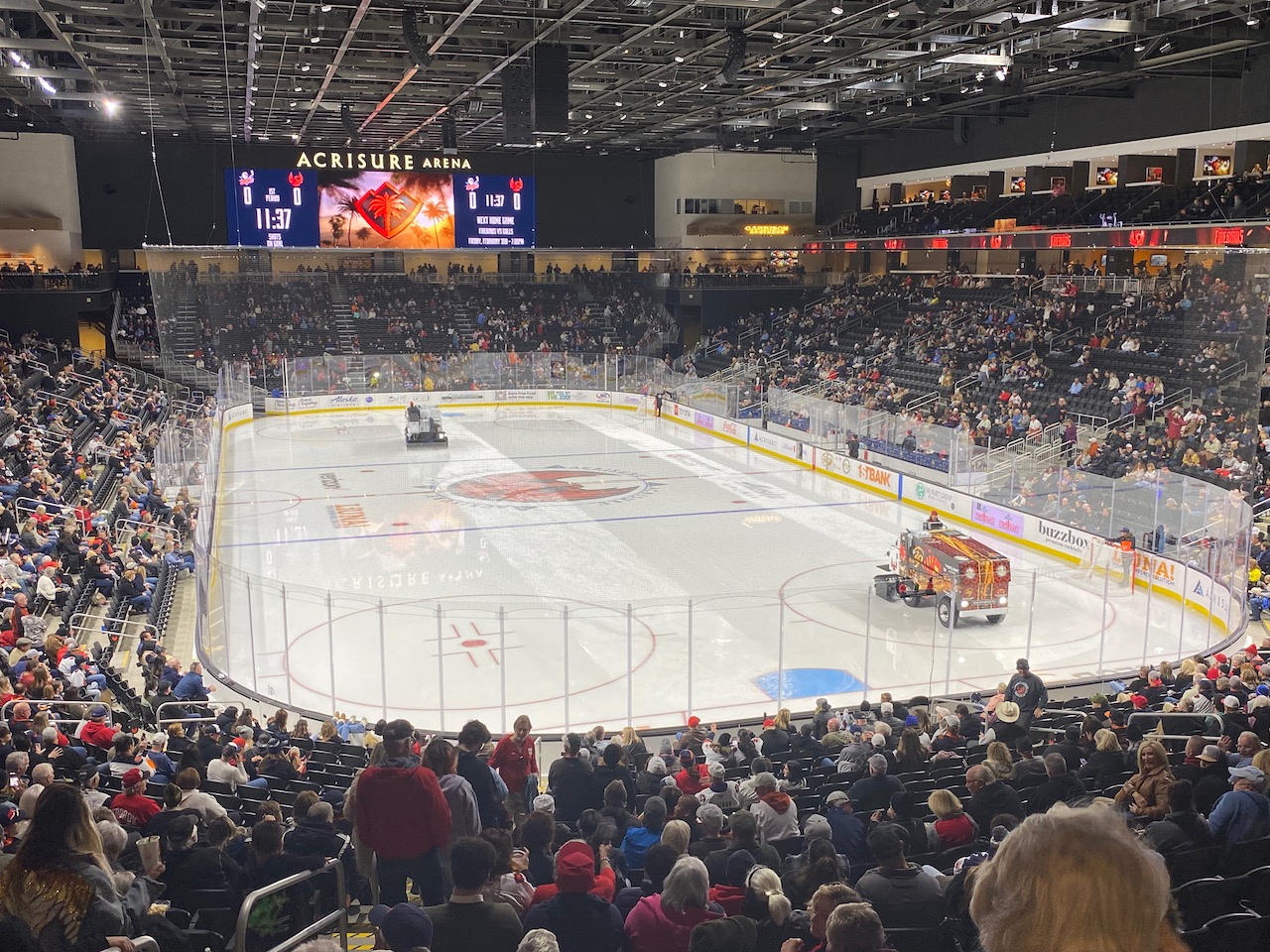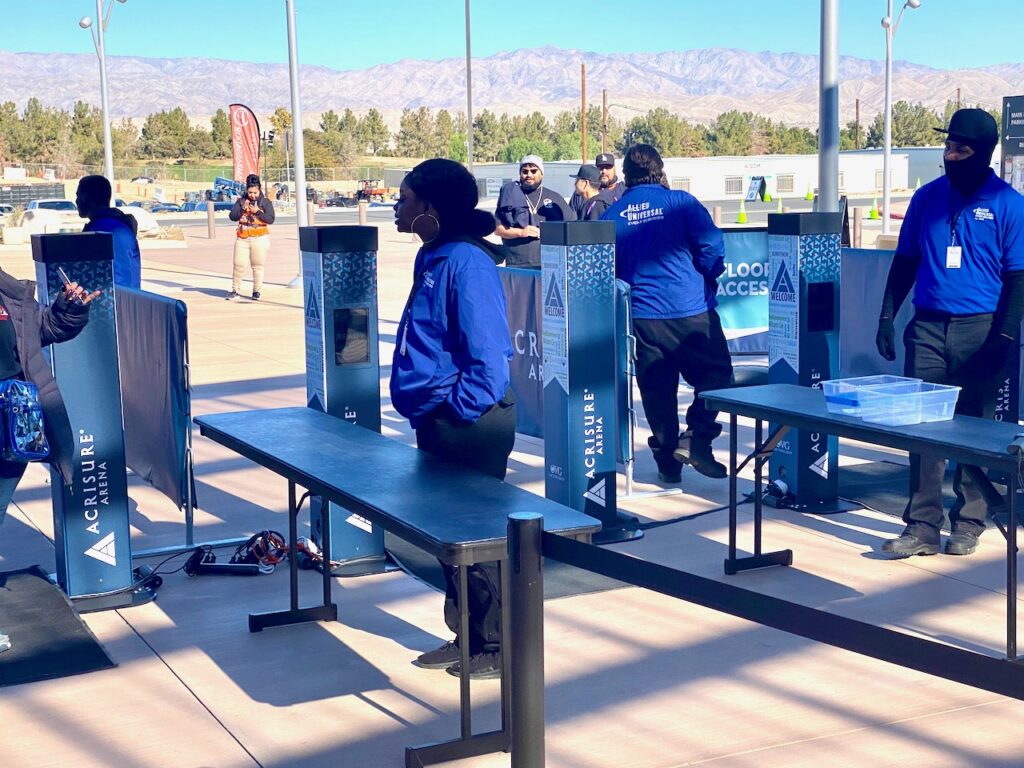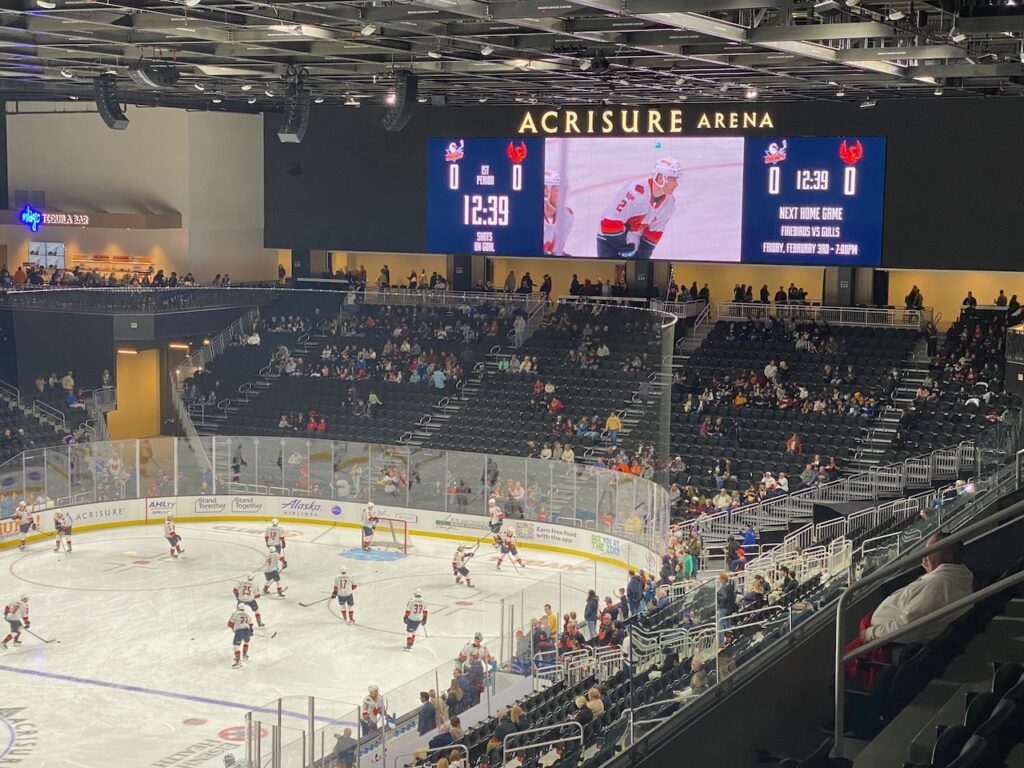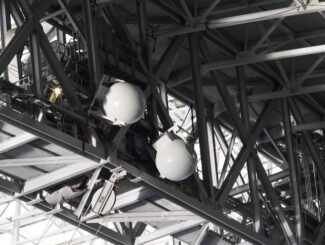
It’s almost the stuff of fever dreams: 28 feet below the sunbaked surface of the southern California desert sits an ice rink that’s home to a professional hockey team. And on at least one Sunday in late January, the arena looked darn near close to capacity.
This dusty corner of the Sonoran desert may not look like the most auspicious place to spend almost $500 million on an 11,000-seat arena. But sports venue developer and manager Oak View Group made that bet and in June 2021 broke ground on Acrisure Arena, 12 miles east of Palm Springs.
As if the combined size and remote location of the venue weren’t enough of a challenge, there’s also the reality that the region is better known for golf and tennis. But OVG was looking to find a home and practice facility for its American Hockey League team, the Coachella Valley Firebirds, the minor league counterpart to the National Hockey League’s Seattle Kraken, which OVG also partially owns.
OVG’s desert bet starts to make more sense when you consider that the Coachella Valley, better known for its eponymous music festival, isn’t the collection of quiet little desert towns it was 20 years ago. The region between Palm Springs and Indio has been filling in steadily, now counting more than 400,000 residents.
Joyce Szudzik, vice president of marketing for Acrisure Arena, said the venue is the right scale for this location, when you consider what else is available in the region for sports and entertainment. McCallum Theatre in nearby Palm Desert has only about 1,200 seats. The “big rooms” of local Native American-owned casinos top out at around 3,500 people. The region has been ripe for a medium-sized facility for some time, Szudzik explained.
OVG also isn’t relying solely on hockey to fill seats at Acrisure. Dave Chappelle and Chris Rock headlined the facility’s grand opening in mid-December 2022. Musical acts on the Acrisure schedule like Shania Twain, Jimmy Buffet and Harry Styles each draw different demographics. And the arena was built with that kind of adaptability in mind. The seats under the main video board retract, a stage goes up, and the hockey rink transforms into a concert hall relatively quickly.
Acrisure’s technology measures up
OVG owns and operates several sports and entertainments venues around the country, and recognized that robust, seamless technology is a baseline customer expectation at facilities like Acrisure.
Verizon handled the technical design and initial management of the IT infrastructure at the new area, said Phil Montford, senior manager of technology for Acrisure Arena. The backbone network is 10-Gigabit Ethernet with redundant dual connections, with switches made by Extreme Networks. This backbone handles all the data, cellular and video needs of the venue, and connects to Acrisure’s two Internet service providers, Spectrum and Frontier.

Two Wi-Fi networks are also in operation; a public SSID for fans, the other for back-of-the-house corporate use. There are 346 Wi-Fi access points across the property, Montford said, also Extreme gear.
Acrisure’s APs are mounted overhead, which Montford views as a benefit that limits exposure to interference. “When you have a bowl like this with its concave shape made of concrete, radio waves tend to bounce around,” he said. “We haven’t had to do much [Wi-Fi] tuning… only a little bit for the first two games.”
Wi-Fi supports other Acrisure requirements like the Xtract One SmartGateways, used at all the arena’s entrances for security screening. With no pocket emptying or shoe removal required, the system is allegedly able to distinguish between a smartphone and a weapon, even a plastic one. The system also makes arena entry six times faster for patrons and reduces staffing costs by 50 percent, according to Szudzik.
Concessions are making limited use of Wi-Fi. Patrons in the arena’s suites can order from a QR code menu. Acrisure’s long term goal is that seats in the premium bowl areas will have QR codes attached to them for in-seat ordering and service, but that capability is not currently activated, said Pablo Villareal, the arena’s director of premium.
Acrisure’s cellular distributed antenna system (DAS) sports eight zones and 146 antennas; it’s currently occupied only by Verizon, though AT&T is expected to join sometime this year.
Connectivity good for fans and back of house
Speed tests of fan-facing Wi-Fi and DAS inside Acrisure showed adequate performance for most attendees. Best overall performance for the Wi-Fi was in Section 127 closest to the concourse entry level of the bowl at 54.43 Mbps upload/50.36 Mbps download; Wi-Fi was slowest in our test in Section 103 at 19.19 Mbps/13.82 Mbps.
Verizon’s DAS proved faster on download speeds and pokier on the upload; best performance was near the top of Section 115 with 81.18 Mbps/16.37 Mbps. Speeds were slowest in our test halfway down in Section 118 at 21.82 Mbps/1.7 Mbps.

Average speeds in our Acrisure tests for Firebirds_Fan_Wi-Fi was 26.71 Mbps/46.43 Mbps; Verizon’s DAS averaged 55.1 Mbps/7.93 Mbps overall.
The Firebirds’ video requirements of the IT infrastructure aren’t inconsequential. Montford and his team ensure there’s a video feed for broadcasting games on AHL-TV; the local ABC affiliate, KESQ, is broadcasting 10 Firebirds’ game this season and draws from the feed. And there’s an in-house radio communication for AHL officials; IP cameras point down over each goal, connected to a server, and an iPad, Montford explained.
“There’s also ViPr cam, which produces a 4K ultra-wide video feed of the entire ice throughout the game and goes straight to the AHL only, for play reviews,” he added. A network-attached storage (NAS) system is used for instant replay; a separate NAS is devoted to inhouse video controls.
Montford is also quick to credit his IT counterparts at other company-owned sporting venues. “OVG has opened five other new arenas in the last 14 months,” he said, noting that his colleagues at these other venues generously shared their knowledge with him. “It’s a pleasure anytime you have a blank slate like this,” Montford said. Acrisure Arena is also aiming to be more carbon-neutral by 2025, taking advantage of all that sunshine with solar energy panels over most of the parking areas. The entire building will be able to operate on a non-game day using 100 percent solar, and 70 percent on a game day, Szudzik noted. “The venue has been thoughtfully designed in a number of ways, by people with years of experience, who understand how things work,” she added.








